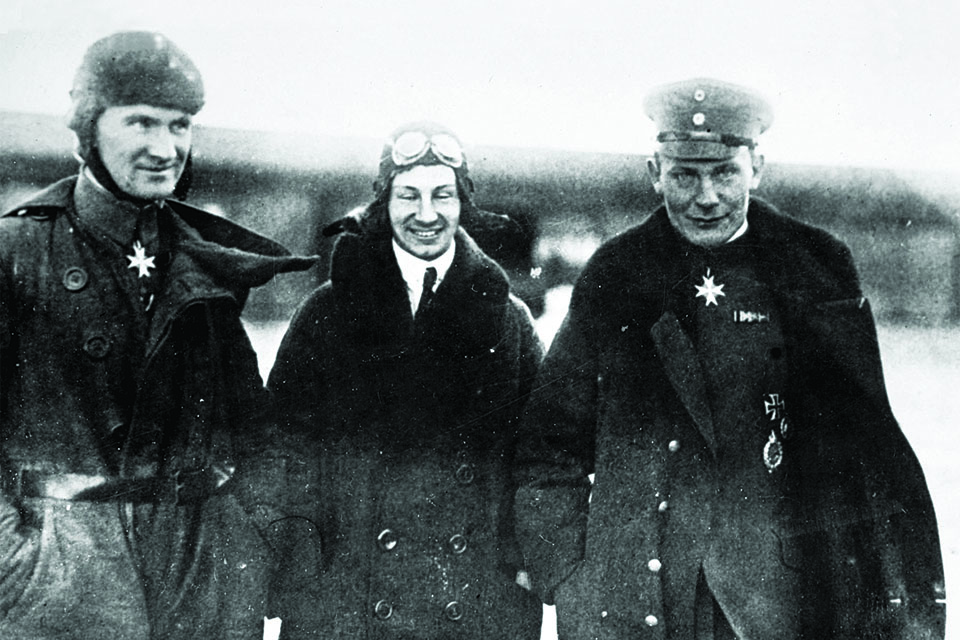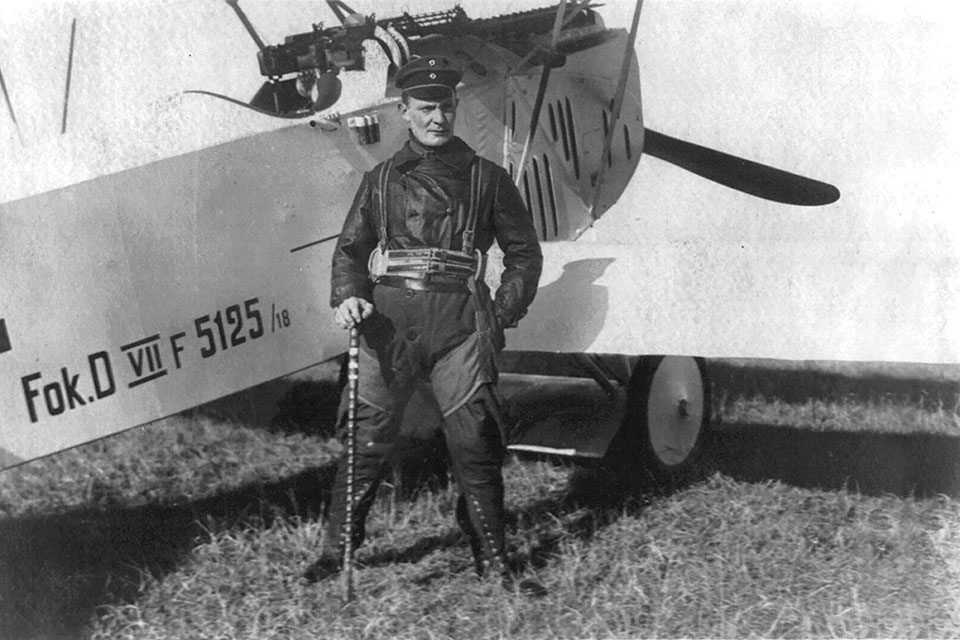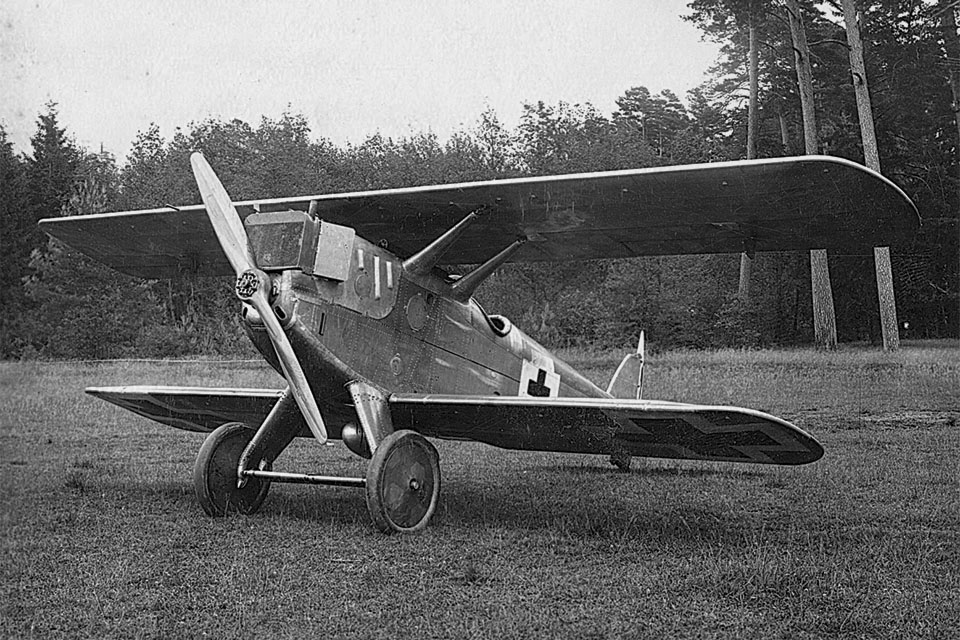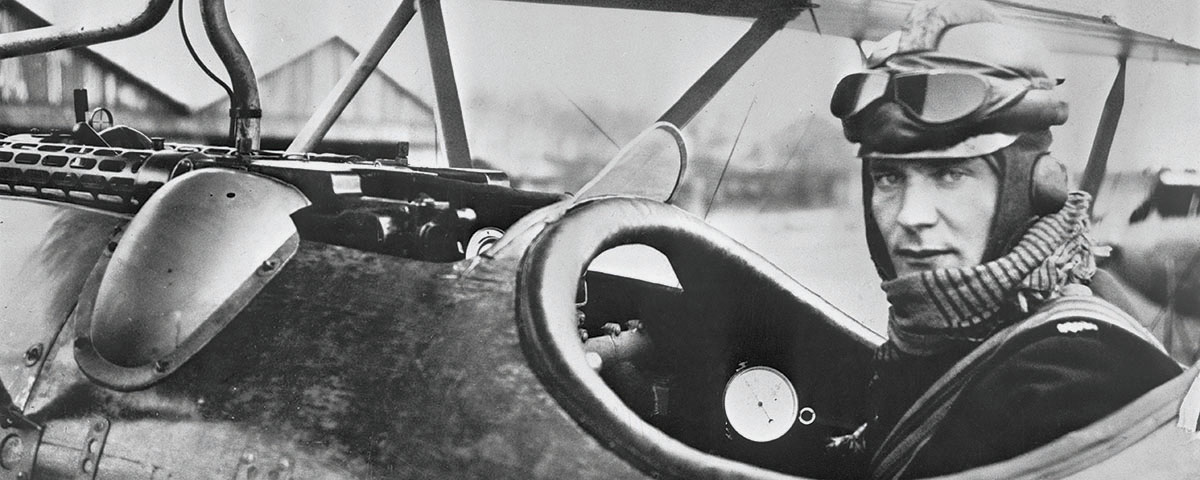Monday evenings in late 1922, the Cafe Neumayr in Munich played host to a collection of unsavory, lower-middle-class war veterans, rabble-rousers, malcontents and would-be revolutionaries, grumbling over Germany’s anarchic postwar politics. Their radical ambitions would likely have come to nothing if not for a visit that November by a true war hero: Hermann Göring, last commander of “Red Baron” Manfred von Richthofen’s “Flying Circus.” He had come to meet the leader of these National Socialists. “I just sat unobtrusively in the background,” he remembered, as Adolf Hitler expounded on the Nazi route to power. “You’ve got to have bayonets to back up your threats. Well, that was what I wanted to hear. He wanted to build up a party that would make Germany strong and smash the Treaty of Versailles. ‘Well,’ I said to myself, ‘that’s the party for me!’”
For his part Hitler, who had risen no further than lance corporal in the army, needed a big name to set his movement apart from the dozens of political parties rending Germany. “Splendid,” he told supporters when Göring signed up, “a war ace with the Pour le Mérite—imagine it! Excellent propaganda!”
After almost a century there’s so much propaganda about Nazi Reichsmarschall Hermann Göring that it’s hard to sift out the truth. His anti-Semitism and weakness for authority figures might well be traced to early childhood. Göring’s elderly father was a German diplomat posted abroad, and Hermann was raised to age three by family friends in Germany. It’s said that on his mother’s return, he slapped her. But thanks to her romantic relationship with their wealthy half-Jewish landlord, Göring’s namesake Dr. Hermann Ritter von Epenstein, Göring enjoyed an aristocratic upbringing in several Bavarian castles. He was teased by schoolmates for his “Jewish father,” whose title (“knight”), like his castles, was purchased rather than inherited. But even when Epenstein took a new mistress and evicted the family, Göring held him in high regard, a sort of life-lesson in Nietzschean will to power.
Prussian military education forged Göring into a promising young infantry officer. In the first days of World War I he led a daring cavalry-style raid via bicycle across the French lines, but in the trenches soon fell ill with rheumatic fever. While he recuperated, friend and fellow lieutenant Bruno Loerzer, training as a pilot in the new German air service, convinced him to become an observer. The story goes that Göring forged transfer papers, in effect deserting his regiment, yet through Epenstein’s intervention was not only spared court-martial but ordered into the air service by Crown Prince Friedrich Wilhelm. Göring found this new kind of war suited his temperament and ambition. “I seem to come alive when I am up in the air and looking down at the earth,” he wrote. “I feel like a little god.”
In a two-seat Aviatik B.II over Verdun, France, Göring and Loerzer quickly gained renown as the go-to reconnaissance team, Loerzer banking low over the target while Göring leaned overboard with a heavy camera. Prince Wilhelm took a personal interest in the two young aviators and awarded both the Iron Cross, First Class, earning them resentment from some of their squadron mates. That didn’t bother Göring, who wrote, “I do not want to be an ordinary person….I want to tower over the human herd, not that I will follow them; rather, that everyone will follow me.” Not satisfied with taking photographs, he used a radio telegraph to direct artillery fire onto French positions, dropped bombs over the side of his airplane and fitted a machine gun to the rear cockpit to spray enemy trenches.
By mid-1915, both sides were fixing forward-firing machine guns to single-seat aircraft, and Göring, who had learned to fly, sought to switch to fighters. There weren’t enough of the new Fokker Eindecker monoplanes to go around, however, so he piloted an Albatros C.I two-seater with a synchronized forward-firing machine gun, and on November 16 he and his observer shot down a French Maurice Farman MF.7.
Finally, on September 28, 1916, Göring was assigned to Jagdstaffel (fighter squadron) 7, or Jasta 7, and then reassigned to Jasta 5 in October. His zealous quest for glory achieved frustratingly little until November 2 when, in a dogfight that would enter Nazi mythology, Göring claimed to have single-handedly attacked a giant Handley Page O/100 bomber and set it aflame before some 20 enemy fighters dived from above. Supposedly out of ammo, shot up and grievously wounded, he barely made it back over the lines to crash-land his Halberstadt D.II beside a field hospital. According to that day’s actual field report, however, he likely attacked a Royal Aircraft Factory B.E.2d two-seater and wasn’t even credited with the kill. Six Nieuports chased him off with a severe hip wound, to crash on his own field, out of action for six weeks. If Göring had never become a Nazi, likely no more would ever have been heard of it.
In March 1917 Göring transferred to Jasta 26 at Habsheim, which was commanded by his old friend Loerzer, and by May 10 he had raised his score to seven. Now an ace, in mid-May he was assigned his first command, Jasta 27, near Lille, France. It was no easy assignment. “Our fighter aeroplanes were mostly technically inferior to those of the enemy,” remembered one squadron pilot. “…We had only three combat-ready aeroplanes there, instead of the eighteen planned. Thus…the Staffel had no aerial victories at all. When we got Leutnant Göring as Staffelführer, it became better, for not only did he already have seven confirmed aerial victories, but also pleaded our case very energetically to the higher-ups.”
If Göring’s aristocratic upbringing afforded him the favor of nobles in the high command, it also tainted his attitude toward underlings. Fellow fighter pilot Rudolf Nebel remembered that Göring “was very standoffish toward his comrades. He was a good pilot, but disliked by his men due to his high-handed manner.”
“I gathered my officers and pilots about me and impressed on them all of the regulations about flying and fighting as a formation,” Göring remembered. “Then I assigned each one his place in the formation….Now everyone had to show what he could do and what he was good for….This is how I wished to put the Staffel to the test.”

On June 8, flying an Albatros D.III with a black fuselage and white nose and tail, Göring led 10 aircraft up over Lille. At 13,000 feet over the Lys River, they were attacked by a dozen Nieuport 23 fighters of No. 1 Squadron, Royal Flying Corps. “My formation split up too early,” Göring later recalled, “and could no longer fight in a unified way.” One of the Nieuports dived on Göring’s tail. Australian 2nd Lt. Frank D. Slee, on his first mission, later wrote, “I will swear I hit his [Göring’s] machine. I could see my tracer bullets,” but he could not outfly him. Shot down, the Aussie crash-landed behind German lines and was taken prisoner, Göring’s eighth victory.
Switching to a new Albatros D.V biplane, Göring soon doubled that score in Belgium during the Battle of Passchendaele in the fall of 1917. His name was put forward for the Orden Pour le Mérite—the Blue Max—but by that time 20 victories were required and he was denied the honor. “I have been flying at the frontlines for three years without having had a compassionate or homeland command [leave],” he wrote despondently. “Now, I feel a certain exhaustion, especially after the heavy fighting in Flanders.”
The pressure and disappointment may have gotten to him. His frequent wingman, Jewish Lieutenant Willi Rosenstein, recalled, “I had a personal quarrel with Göring, caused by an anti-Semitic remark in front of all comrades in the officer’s Mess at Iseghem, Flanders. I had been compelled to demand its revocation. These circumstances caused me to apply for my transfer to a home defense unit, which was granted after a short time.” Göring brushed off the incident as evidence of Rosenstein’s nervous exhaustion. It was his squadron’s loss: Rosenstein would go on to score nine victories, mostly with Jasta 40c.
Jasta 27 was soon folded into one of the new Richthofen-style fighter wings, Jagdgeschwader III (JG.III), under command of Loerzer, now a 20-victory ace with the Blue Max. Göring, in a new Fokker Dr.I triplane, green with white nose and tail, downed a Royal Aircraft Factory R.E.8 of No. 42 Squadron of Britain’s newly formed Royal Air Force on April 7, 1918, for his 18th victory. No less than the commanding general of the German air service, Ernst von Hoeppner, now recommended him for the Pour le Mérite. Despite still being short of the requisite victories, Göring soon lived up to the award, using a pair of new Fokker D.VIIs to claim a French Dorand AR.1 (more likely a Breguet 14) on June 3, a Spad VII on the 9th and a Spad XIII on the 17th.

With 21 victories to his credit, Göring was invited to Berlin in July to attend tests of new aircraft prototypes. Among those present was Richthofen’s successor as JG.I commander, Captain Wilhelm Reinhard, whose death in a flying accident at the event shocked everyone (see sidebar, below). Who would assume Germany’s most prestigious fighter command? JG.I consisted of Richthofen’s handpicked top guns, many with more victories than Göring: Erich Löwenhardt (with 35), Ernst Udet (40) and even the Red Baron’s younger brother Lothar (29). All three had served as squadron leaders, all three wore the Pour le Mérite, all three might have expected to take over JG.I. Though Lothar was out of action, wounded, Udet and Löwenhardt were already vying for the top slot when word came that it had gone to Göring. Udet supposedly remarked, “My God, they have chosen an outsider.”
To command did not require a high score; Reinhard only had 12 victories when the Red Baron personally chose him as successor, and 20 at the time of his death. Still, on July 14 Göring took up his new command with a note of proper humility, telling the assembled aces, “…there are no better fliers in all the world than those I see before me now. I hope I shall be worthy of your confidence and your trust.” JG.I adjutant Karl Bodenschatz wrote in his diary, “The new commander has got off to a good start.”
All that changed on July 18, however, when Göring took off with the Flying Circus. Reinhard had been in the habit of leading only on the ground, in the air handing off to one or another of the top aces and letting formation tactics unravel to a “free hunt,” with every man for himself. The aces set about racking up their own scores, leaving lesser pilots to fend for themselves—the kind of dogfight that had seen the Red Baron himself killed. No longer. Göring told Bodenschatz, “The peacocks need to be plucked before they fall over their own feathers.” Assembling the top guns, he decreed that their seconds-in-command would lead the squadrons, while they flew as Göring’s wingmen.
On that day, the Allies, having held off the last German offensive along the Marne River, launched their counteroffensive. In his D.VII 324/18, yellow with a red nose, Göring led JG.I to intercept Allied bombers over Neuilly, but held his squadron leaders back while their men attacked, only then turning loose the big guns. Losing just two of their own, JG.I scored 13 kills, including two by Löwenhardt and one by Göring, his 22nd victory. “I attacked some Spads,” he recalled. “I pressed one downward and, in a turning battle, shot it down.”
On the ground the Germans began a retreat that would continue to the end of the war, but in the air JG.I enjoyed a new era of success. Having scored its 500th kill shortly after Göring’s arrival, in the four months of his command the fighter wing added 144 more, despite the loss of Löwenhardt (killed, with 54 victories) and Lothar von Richthofen (wounded again, with 40). Udet, becoming Göring’s friend, raised his tally to 62 and would be the highest-scoring surviving German ace. Göring, famously flying an all-white D.VII, finished the war with an official score of 22, of which at least 18 can be confirmed from Allied losses.
For Germans troops at the front, the war’s end was shockingly abrupt, marked by mutiny, rebellion and revolution. General Erich Ludendorff, chief of staff, would blame final defeat on the German army being “stabbed in the back” by unpatriotic civilians, socialists, Bolsheviks, Republicans and Jews, which explained everything to right-wing, militaristic Germans like Göring. The fighter wing commander refused to surrender JG.I’s aircraft either to the enemy or mutinous German troops; his men deliberately crashed them and sabotaged their guns. The night JG.I was disbanded, Göring raised a glass to his surviving pilots. “The forces of freedom and right and morality will win through in the end,” he told them. “We will fight against these forces which are seeking to enslave us, and we will win through. Those same qualities which made the Richthofen Squadron great will prevail in peacetime as well as in war. Our time will come again.”
On December 18, 1918, Göring attended a meeting at the Berlin Philharmonic, where officers invited to support the revolutionary government were told to leave their insignia and decorations at home. Göring arrived in full regalia, including his Pour le Mérite, and told the crowd: “The ones who are to blame are the ones that stirred up the people, who stabbed our glorious army in the back. I ask everyone here tonight to cherish a hatred, a deep and abiding hatred for these swine who have outraged the German people and their traditions. The day will come when we will drive them from our Germany.”
As his Germany sank into chaos, Göring moved to Denmark and Sweden, where he met his future wife, the Baroness Carin von Kantzow. Yet he felt himself drawn homeward to “wipe out the disgrace of Versailles—the shame of defeat, the [Danzig] corridor right through the heart of Prussia.” Of the hodgepodge of German political parties squabbling for power, Nazism reeled him in. “I joined the Party because it was revolutionary, not because of the ideological stuff,” Göring later explained. “…The thing that attracted me to the Nazi Party was that it was the only one that had the guts to say ‘to hell with Versailles,’ while the others were smiling and appeasing. That’s what got me.”
What got him, and what he made of it, are two different things. The war hero Göring became head of the Nazi stormtroopers, founded the infamous Gestapo secret police and authorized the “Final Solution,” which slaughtered six million Jews—a fat, pompous morphine addict who drove Udet to suicide and bungled the air war over Europe until his top pilots rebelled, Hitler repudiated him and Göring finally faced justice as a war criminal. Yet to the end he defied the prosecutors, interrogators and psychiatrists trying to understand him.
“All nonsense,” he told them at Nuremberg of his many biographies, shortly before he took cyanide and cheated the hangman. “Nobody knows the real Göring.”
Fate Picks Göring
The pace of World War I air warfare required constant innovation, so in mid-1918 the German air service staged a competition at Adlershof in suburban Berlin to evaluate new fighters to succeed the Fokker D.VII. Germany’s best aircraft factories submitted prototypes, including the Pfalz D.XII, Fokker E.V, Junkers D.I and Siemens-Schuckert D.IV. One of the most advanced designs came from the Zeppelin company’s Claude Dornier. His Zeppelin-Lindau D.I was in many ways ahead of its time: an all-metal monocoque (stress-bearing skin) fuselage, cantilever torsion-box wings and even a jettisonable external fuel tank. Its upper wing was attached to the fuselage by just four cabane struts, with neither support wires nor interplane struts. Rushed through design and construction to meet the competition deadline, a prototype was sent by train to Adlershof. The frontline fighter pilots in attendance are said to have looked with distrust on that upper wing design, and their misgivings were not misplaced; reportedly a Zeppelin factory hand had discovered its attachment points were weak, but his warning was either never received or ignored.

When other pilots hesitated to fly the D.I, Hermann Göring, commanding officer of Jasta 27, volunteered. By all accounts he wrung it out right over the heads of the assembled high command. According to biographer Leonard Mosley, who knew Göring personally, “To use an old fighter pilot’s term, he ‘beat up’ the airfield at practically nought feet, both right side up and upside down. He looped and spinned and yawed, and, finally after a particularly awe-inspiring flight down the airfield on canted wings, he brought it to a landing and leaped out, laughing with delight at the expressions on the faces of the spectators.”
Accusations that Göring somehow tampered with the aircraft are unfounded. Both Leutnant Kurt Schwarzenberger, chief test pilot for the experimental fighter division, and Leutnant Constantin Krefft, technical officer of Jasta 11 and Jagdgeschwader I, demonstrated the D.I after Göring without mishap. All agreed that with its 160-hp Mercedes D.III engine, the D.I was a superior design.
Then Manfred von Richthofen’s successor, JG.I commander Wilhelm Reinhard, took over. He immediately climbed to over 3,000 feet, but the previous workouts must have overstressed those cabane struts. As he came back down, observers were horrified to hear a crack and see the airplane’s top wing rip off. With no parachute, Reinhard rode the D.I down and was killed on impact.
A replacement D.I, with strengthened struts and 185-hp BMW engine, participated in the third fighter competition just before war’s end, but its top speed of 124 mph was by then judged too slow. In 1921 the U.S. Army and Navy bought two for evaluation. America’s Curtiss P-1 Hawk and Boeing Model 15 fighters would owe more to the older Fokker D.VII, however, and the D.I’s primary role in aviation history was as Göring’s ride to destiny.
For additional reading, frequent contributor Don Hollway suggests: Hermann Göring: Fighter Ace, by Peter Kilduff; and Hermann Goering in the First World War, by Blaine Taylor.
This feature originally appeared in the January 2019 issue of Aviation History. Subscribe today!
Ready to build your own copy of Göring’s all-white Fokker D VII? Click here!





